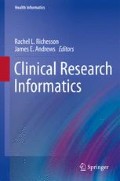Abstract
Data sharing is extremely important for a number of reasons, and its importance is increasing rapidly as we generate more and more information and data in new areas such as genomics. At the core, the value of data sharing is to allow different technology tools to work together to improve currently antiquated clinical research processes; however, data sharing can also serve to leverage the global uptake of electronic health records to improve workflow and enhance the link between research and healthcare. From the point of view of the patient, data sharing will allow for aggregation of sufficient data to support robust analyses and/or comparisons across studies that will increase the quality of research knowledge gained from healthcare. The concept of data sharing is critical to the advancement of healthcare, which relies on research information for informed clinical decisions. Despite the recognized value of data sharing for the benefit of patients, which includes all of us, there are inherent challenges yet to be overcome. These include, but are not limited to regulations, trust and patient privacy, slow adoption of information technology and standards, as well as workflow, content and technical issues. This chapter focuses on efforts to address these challenges - in particular, collaborations among standards developing organizations and others to develop, harmonize and support interoperability among the standards and to improve workflows between clinical care and research processes. Currently available opportunities and initiatives with significant promise are identified, yet the importance of a stepwise, iterative approach is recognized.
Access this chapter
Tax calculation will be finalised at checkout
Purchases are for personal use only
References
Bloomrosen M, Detmer D. Advancing the framework: use of health data – a report of a working conference of the American Medical Informatics Association. JAMIA. 2008;15:715–22.
Kahn MG, Kaplan D, Sokol RJ, DiLaura RP. Configuration challenges: implementing translational research policies in electronic medical records. Acad Med. 2007;82:661–9.
Kim D, Labkoff S, Holliday SH. Opportunities for electronic health record data to support business functions in the pharmaceutical industry – a case study from Pfizer, Inc. JAMIA. 2008;15:581–4.
Prokosch HU, Ganslandt T. Perspectives for medical informatics: reusing the electronic medical record for clinical research. Methods Inf Med. 2009;48:38–44.
Bishop S. Presentation at conference of the Drug Information Association presentation, Madrid; 2007.http://www.diahome.org/NR/rdonlyres/E1D7FCCF-6CF2-46E2-A676-817D2639BBE0/765/Program1.pdf.
Ibara M. ASTER Study (ADE Spontaneous Triggered Event Reporting), presentation at conference of the Drug Information Association. June 2009. http://www.asterstudy.com/index.php?option=com_content&view=article&id=10:aster-description. Accessed 13 July 2011.
CDISC. Glossary, applied clinical trials. 2008. http://www.cdisc.org/stuff/contentmgr/files/0/be650811feb46f381f0af41ca40ade2e/misc/cdisc_2008_glossary_version_7_0.pdf or www.cdisc.org/glossary. Accessed 13 July 2011.
Ohmann C, Kuchinke W. Future developments of medical informatics from the viewpoint of networked clinical research. Methods Inf Med. 2009;48:45–54.
Lamont J. How KM can help cure medical errors. 2005. KM World www.kmworld.com/Articles/Editorial/Feature/ow-KM-can-hel-cure-medical-errors-9606.aspx. Accessed 13 July 2011.
Clinical Trials.gov. Homepage. 2010. http://clinicaltrials.gov/. Accessed 13 July 2011.
WHO. International clinical trials registry platform. 2010. http://apps.who.int/trialsearch/. Accessed 19 Dec 2012.
Kush RD, Bleicher P, Kubick W, Kush ST, Marks R, Raymond S, Tardiff B. eClinical trials: planning and Implementation. Boston: Thompson CenterWatch; 2003.
CDISC. Healthcare link. 2010. http://www.cdisc.org/healthcare-link. Accessed 13 July 2011.
CDISC. Mission & principles. 2010. http://www.cdisc.org/mission-and-principles. Accessed Aug 2011.
de Montjoie AJ. Introducing the CDISC standards: new efficiencies for medical research. CDISC. 2009;2009:76.
CDISC. eSource data interchange. http://www.cdisc.org/esdi-document. Accessed 13 July 2011.
CDISC. Biomedical research integrated domain group (BRIDG) model. 2010. www.bridgmodel.org or http://www.cdisc.org/bridg. Accessed 13 July 2011.
JIC (Joint Initiative Council). Global Health Informatics Standardization. http://www.global-e-health-standards.org/. Accessed 13 July 2011.
Wikipedia. Interoperability. 2010. http://en.wikipedia.org/wiki/Interoperability. Accessed 13 July 2011.
Sujansky W. Methodological review. Heterogeneous database integration in biomedicine. J Biomed Inform. 2001;34:285–98.
CDISC. Protocol representation model – study design – http://www.cdisc.org/protocol or Study/Trial Design Model – http://www.cdisc.org/study-trial-design. 2010. Accessed 13 July 2011.
Mead C. Data interchange standards in healthcare IT – computable semantic interoperability: now possible but still difficult, do we really need a better mousetrap? J Healthc Inf Manag. 2006;20:71–8.
Weng C, Gennari J, Fridsma DB. User-centered semantic harmonization: a case study. Biomed Inform. 2007;40:353–64.
Hammond WE, Jaffe C, Kush R. Healthcare standards development: the value of nurturing collaboration. AHIMA. 2009;80:44–50.
CDISC. Standards. 2010. http://www.cdisc.org/standards. Accessed 13 July 2011.
Kwak YS, Dickerson A. Just what the doctor ordered-the benefits of health informatics. ISO Focus. 2009;6:35–7.
SHARE. CDISC shared health and clinical research electronic library. 2010. http://www.cdisc.org/cdisc-share. Accessed 13 July 2011.
Mobed K, et al. AMIA summit posters on ontologies and ontomappers. 2009. http://ctsi.ucsf.edu/informatics. Accessed 13 July 2011.
CDISC. Life sciences industry architecture white paper. 2007. http://www.cdisc.org/stuff/contentmgr/files/0/33af249eae6b3d649052bf232d34e6d9/misc/benefits_lifesciencesindustryarchitecture.pdf. Accessed 13 July 2011.
Poh Alisa. Integrating lead discovery. BioIT World. 2009;8(4):26. http://www.tectrends.com/tectrends/article/00175337.html. Accessed 13 July 2011.
National Center for Research Resources. Clinical Translational Science Awards. 2010. http://www.ncrr.nih.gov/clinical_research_resources/clinical_and_translational_science_awards/. Accessed 13 July 2011.
Partners Healthcare. Informatics for integrating biology and the bedside. 2010. https://www.i2b2.org/. Accessed 13 July 2011.
National Cancer Institute. caBIG. 2010. https://cabig.nci.nih.gov. Accessed 13 July 2011.
EMEA. Reflection paper on expectations for electronic source. 2010. Link to the page: http://www.ema.europa.eu/ema/index.jsp?curl=pages/regulation/document_listing/document_listing_000136.jsp&jsenabled=true. Link to the document: http://www.ema.europa.eu/docs/en_GB/document_library/Regulatory_and_procedural_guideline/2010/08/WC500095754.pdf. Accessed 13 July 2011.
Kush R, Alschuler L, Ruggeri R, Cassells S, Gupta N, Bain L, Claise K, Shah M, Nahm M. Implementing single source: the STARBRITE proof-of-concept study. JAMIA. 2007;14:662–73.
IHE. Retrieve form for data capture. 2009. http://wiki.ihe.net/index.php?title=Retrieve_Form_for_Data_Capture. Accessed 13 July 2011.
EHRA. Letter of endorsement for RFD. 2008. http://www.cdisc.org/stuff/contentmgr/files/0/f5a0121d251a348a87466028e156d3c3/miscdocs/ehra_cdisc_endorsement_letter_100908.pdf. Accessed 13 July 2011.
CAMD. 2010. http://www.c-path.org/CAMD.cfm. Accessed Aug 2011.
Butte AJ. Translational bioinformatics: coming of age. J Am Med Inform Assoc. 2008;15(6):709–14.
Kush RD, Helton E, Rockhold FW, Hardison CD. Electronic health records, medical research and the tower of Babel. N Engl J Med. 2008;358:1738–40.
Author information
Authors and Affiliations
Corresponding author
Editor information
Editors and Affiliations
Rights and permissions
Copyright information
© 2012 Springer-Verlag London Limited
About this chapter
Cite this chapter
Kush, R.D. (2012). Data Sharing: Electronic Health Records and Research Interoperability. In: Richesson, R., Andrews, J. (eds) Clinical Research Informatics. Health Informatics. Springer, London. https://doi.org/10.1007/978-1-84882-448-5_17
Download citation
DOI: https://doi.org/10.1007/978-1-84882-448-5_17
Published:
Publisher Name: Springer, London
Print ISBN: 978-1-84882-447-8
Online ISBN: 978-1-84882-448-5
eBook Packages: MedicineMedicine (R0)

